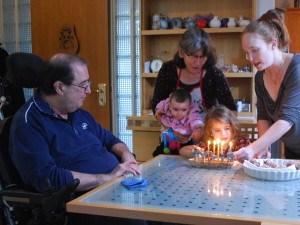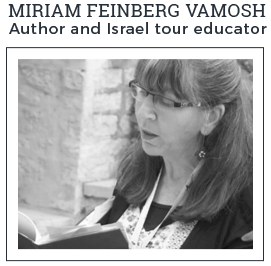What “a Mother” Wants: Tale of Darkness – Season of Light
What “a Mother” Wants: Tale of Darkness – Season of Light
On this, the seventh night of Hanukkah 2014, I would like to jump into the debate on the meaning of the festival – admiration for the fight against tyranny, esteem/excoriation of cultural separatism, paganism at midwinter – the sky’s the limit. For my part, at the risk of being considered the Grinch who stole Hanukkah, I would like first to focus on a tragic heroine, Hannah.
This is not the Hannah whose fervent prayers at Shiloh were rewarded with the birth of a son who served the sacred and grew up to lead Israel through war, peace, and extreme regime change. This Hannah is still nameless when she appears in 2 Macc. 7:1 as “mother” and later in that chapter, “the woman,” who watched her seven sons tortured and executed one after the other, and who triumphed in their sacrifice to a higher cause.
Yes, I admit, I’m feeling more than a bit grinchy these days, in light of Arik’s and his mother’s ongoing medical challenges since their car was struck in May. And so I’d better quickly tell you that our little family, from great-grandma Tamar herself down to seven-month old Elia, enjoyed our holiday very much, lighting the candles, singing the blessings, eating jelly donuts we made and thinking of Nili and Ami who will be home with us soon. In the photos at the end of this post, you’ll see the Vamosh-Dubinsky family celebrating Hanukkah from generation to generation. Below is a teaser.
But bear with me as I return to a tale of darkness at this season of light. We learn that the story of this mother evolved as it wended its way from the Book of Maccabees to rabbinic tradition and on into Christian tradition. Scholars say that “the woman” of 2 Maccabees and in the version told by Rab Judah in the Babylonian Talmud (Gittin 57b) becomes Miriam in other rabbinic literature, and Maryam in Syriac Christian sources.
It was only in an early 16-century revision of a 10th-century work, “Josippon,” that she received the name that came down in history. There, the author apparently could not resist a connection with 1 Sam. 2:5, where the biblical Hannah praises her miraculous reversal of fortune: “Those who were full go out to work for bread. But those who were hungry are filled. She who could not give birth has given birth to seven.” Scripture teaches, by the way, that seven sons are the ultimate symbol of divine blessing (Ruth 4:15, Jeremiah 15:9, Job 1:2).
According to 2 Macc. 7: 20-23: “…the mother was marvelous above all, and worthy of honorable memory: for when she saw her seven sons slain within the space of one day, she bare it with a good courage, because of the hope that she had in the Lord. Yea, she exhorted every one of them in her own language, filled with courageous spirits; and stirring up her womanish thoughts with a manly stomach, she said unto them, I cannot tell how ye came into my womb: for I neither gave you breath nor life, neither was it I that formed the members of every one of you; But doubtless the Creator of the world, who formed the generation of man, and found out the beginning of all things, will also of his own mercy give you breath and life again, as ye now regard not your own selves for his laws’ sake.”
To the narrator, this horrific tale seems to be not much more than a human interest angle, because right after he completes his account with the death of the mother, like a news anchor pressed to get everything in before the commercial, in a meanwhile-in-other-news tone, he says: “Let this be enough now to have spoken concerning the idolatrous feasts, and the extreme tortures” (2 Macc. 7:42). He then moves on to a security-related story – Judah Maccabee’s draft efforts and subsequent battles, where his victories as a guerrilla warrior lionized him for all time.
I’ve learned in studying about daily life of women in the Bible that the convoluted family ties of the patriarchs and the matriarchs, with their subterfuge, violence, humiliation and other dysfunctions, were about the perpetuation of family lines at a time when so many died young. But martyrdom is a very different call, one whose circumstances I am fortunate not to be able to imagine.
Some people point out that the lessons of Hanukkah are best served not by glorifying the battles of Judah the Maccabee, but by focusing on the achievements of his brother Jonathan who succeeded him, and is said to have excelled at treaties. But eventually, “us against them” was supplanted (again) by “us against us.” Jonathan’s great-great grandnephews, the sons of Queen Alexandra (Salome) and her second husband, divided the nation in a deadly feud. It can be said that their unceasing and bloody machinations were what eventually brought on Rome’s conquest of our land.
In Gittin 57b Rab Judah intersperses his instances of martyrdom (interestingly, the story of Masada is not among them) with, as was the norm, appropriate biblical proof texts. Transforming the mother’s death at the hands of the tyrants into suicide in his retelling, Rab Judah says: “the woman went up on to a roof and threw herself down and was killed. A voice thereupon came forth from heaven saying, A joyful mother of children.”
“A joyful mother of children”: That reference to Psalm 113:9 is simply chilling. It forces us to ask when death might be perceived as a preferable alternative, even a glorious one. And thus, it forces us to demand of our leaders and those of our neighbors – in our “own language, filled with courageous spirits” – everything possible to rein in extremists, a task we must undertake in honor of the exhortation of Deuteronomy 30:19: “Choose life, that that thou mayest live, thou and thy seed.”

Maya, at right, now with her own seeds, Tamar and Elia, lighting the candles with us, Hanukkah 2014.
* “In the Candles’ Rays I see,” by Elma Ehrlich Levinger, a Hanukkah hymn written in 1960.










Trackbacks & Pingbacks
[…] https://miriamfeinbergvamosh.com/what-a-mother-wants-tale-of-darkness-season-of-light/. […]
Comments are closed.